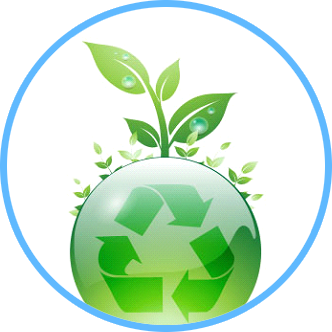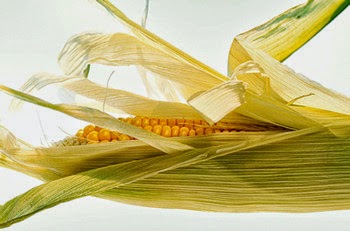What is a biopolymer?

Biopolymers are polymers that are biodegradable. The input materials for the production of these polymers may be either renewable (based on agricultural plant or animal products) or synthetic. There are four main types of biopolymer based respectively on:
1. Starch
2. Sugar
3.Cellulose
4.Synthetic materials
Current and future developments in biodegradable polymers and renewable input materials focus relate mainly to the scaling-up of production and improvement of product properties. Larger scale production will increase availability and reduce prices.
Applications
BenefitsTowards sustainable products?
Further information/ credits
BenefitsTowards sustainable products?
Further information/ credits
Currently either renewable or synthetic starting materials may be used to produce biodegradable polymers. Two main strategies may be followed in synthesizing a polymer. One is to build up the polymer structure from a monomer by a process of chemical polymerization. The alternative is to take a naturally occurring polymer and chemically modify it to give it the desired properties. A disadvantage of chemical modification is however that the biodegradability of the polymer may be adversely affected. Therefore it is often necessary to seek a compromise between the desired material properties and biodegradability.
Applications
Polymers have properties that make them suitable for use in protecting products from moisture, increasing shelf-life and making products easier to dispense.
Every biopolymer has its own material-specific properties, e.g. barrier properties such as oxygen permeability. The barrier properties are relevant to the choice of biopolymers for the packaging of particular products. Bioplastics have very promising prospects for use in pesticide soil pins, for packaging in-flight catering products and for packaging dairy products.
1. Starch based polymers
ApplicationsThermoplastic starch is unsuitable for packaging liquids. It can sustain only brief contact with water. It has good oxygen barrier properties.
SourcesStarch is a natural polymer which occurs as granules in plant tissue, from which it can easily be recovered in large quantities. It is obtained from potatoes, maize, wheat and tapioca and similar sources. Starch can be modified in such a way that it can be melted and deformed thermoplastically. The resulting material is thus suitable for conventional plastic forming processes such as injection moulding and extruding.
2. Sugar based biopolymers
ApplicationsPolyalctides decompose harmlessly in the human body and have therefore long been used for medical applications. Examples include surgical implants which do not require operative removal. Until recently, it was not feasible to use polylactides for packaging because of their high price, around US$500 per kilogram.
Sources• The starting material for Polyhydroxibutyrate is made from sucrose or starch by a process of bacterial fermentation. Varying the nutrient composition of the bacteria produces differences in the end product. This makes it possible to tune the properties of the material, e.g. its moisture resistance. The polymer can be formed by injection, extrusion, blowing and vacuum forming.
• Polylactides (lactic acid polymers)are made from lactic acid, which is in turn made from lactose (or milk sugar) obtained from sugar beet, potatoes, wheat, maize etc. Polylactides are water resistant and can be formed by injection moulding, blowing and vacuum forming
3. Cellulose based biopolymers
ApplicationsFamiliar applications of cellophane include packaging for CDS, confectionary and cigarettes. The material is gradually falling out of favour, however, owing to its high price (about US$6 per kilogram). Other cellulose polymer materials (e.g. cellulose ilm) have also been commercially available for many years but are losing market share to newer polymers such as polypropylene.
SourcesThe use of cellulose for making packagin material such as cellophane is long established. The material is transparent and has good folding properties. Whether in the form of pure cellulose or of a nitrocellulose coating, the material is wholly biodegradable and can be composted by existing waste processing plant.
4. Synthetic based biopolymers
ApplicationsThe relatively high price of biodegradable polymers of synthetic substances, e.g. aliphatic aromatic copolyesters has prevented them from reaching a large scale market. The best known application is for making substrate mats.
SourcesSynthetic compounds derived from petroleum can also be a starting point for biodegradable polymers, e.g. aliphatic aromatic copolyesters. These polymers have technical properties resembling those of polyethylene (LDPE). Although these polymers are produced from synthetic starting materials, they are fully biodegradable and compostable.
Benefits
Besides being available on a sustainable basis, biopolymers have several economic and environmental advantages. Biopolymers could also prove an asset to waste processing. For example, replacing the polyethylene used in coated papers by a biopolymer could help eliminate plastic scraps occurring in compost.
Consumers have a lively interest in biopolymers too. Conventional plastics are often seen as environmentally unfriendly. Sustainable plastics could therefore provide an image advantage.
The major advantage of biodegradable packaging is that it can be composted. But the biodegradability of raw materials does not necessarily mean that the product or package made from them (e.g. coated paper) is itself compostable.
Biopolymers can also have advantages for waste processing. Coated paper (with e.g. polyethylene) is a major problem product for composting. Although such materials are usually banned from inclusion in organic waste under separate collection schemes, some of them usually end up nonetheless in the mix. The paper decomposes but small scraps of plastic are left over in the compost. The adoption of biopolymers for this purpose would solve the problem.
Widespread interest for biopolymers among consumers. Conventional plastics are environmentally unfriendly in the public perception. Sustainability can provide an image benefit. The environmental benefits of biodegradable packaging must be reflected in cost advantages, if large-scale applications are to become feasible. In the short term, it would be preferable to communicate the functional advantages of biodegradable packaging rather than its compostability.
Towards sustainable products?
Whether the use of biopolymers will contribute to a more sustainable society is a question that will have to be studied by a representative life cycle analysis (LCA) of each application and by comparison with existing applications. Representative LCAs are needed at material and product levels; they must make allowance for future developments in biopolymers and take account of all relevant environmental impacts associated with the complete product life cycle, including the depletion of raw materials, the agricultural use of fertilizers and pesticides, transportation, utilization and waste disposal.
Further information
Kiem Product Development Support - Rapenburgerstraat 109 - 1011 VL Amsterdam
tel: +31 (0)20 6385678 - fax: +31 (0) 20 6384905
e-mail: [email protected]
tel: +31 (0)20 6385678 - fax: +31 (0) 20 6384905
e-mail: [email protected]
Nederlands Verpakkingscentrum - P.O.Box 164 - 2800 AD Gouda
tel: +31 (0)182 512411- fax: +31 (0)182 512769
tel: +31 (0)182 512411- fax: +31 (0)182 512769
AgLink, business constructors - P.O. Box 188 - 6700 AD Wageningen
tel: +31 (0)317 467667 fax: +31 (0)317 467660
e-mail: [email protected]
URL: www.agriholland.nl
tel: +31 (0)317 467667 fax: +31 (0)317 467660
e-mail: [email protected]
URL: www.agriholland.nl
Proterra International Centre for Agro-Based Materials - P.O. Box 188 - 6700 AD Wageningen
tel: +31 (0)317 467660
e-mail: [email protected]
tel: +31 (0)317 467660
e-mail: [email protected]
This material issue, About Biopolymers, is based on the report ‘Tenminste houdbaar tot: verpakken met biopolymeren’ , compiled by ‘het Nederlands Verpakkingscentrum’, AgLink, KIEM and Proterra.
The project was subsidized by the Dutch Ministry of Economic Affairs.

Really a brilliant article.went with good information on BIOPOLYMERS.
ReplyDeleteThank You, Am a student of Biopolymers,For the purpose of study i've collected many information,,So i just posted it on my blog.
DeleteCheck all my education related posts.
https://attittudeblogger.in/search/label/Education.